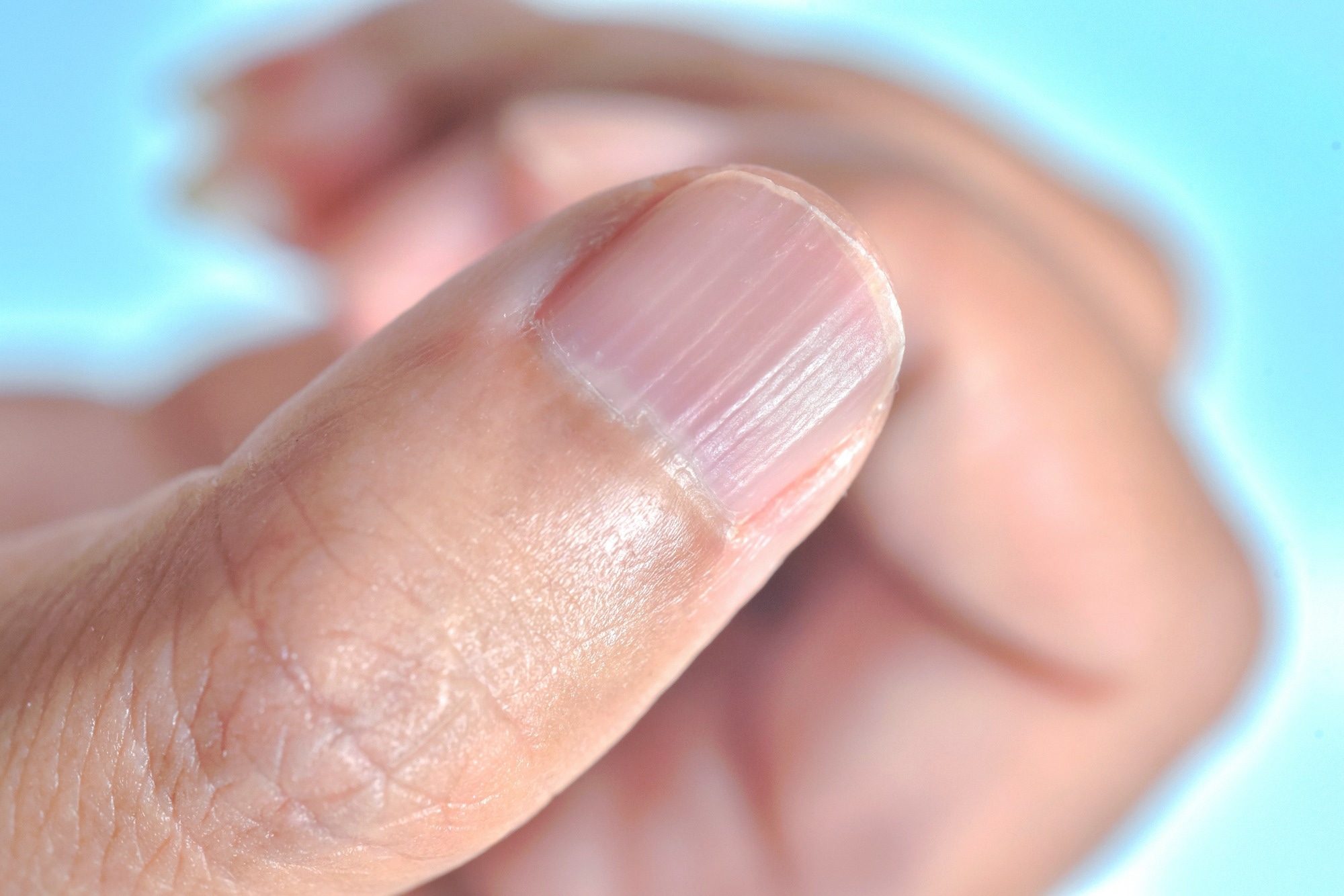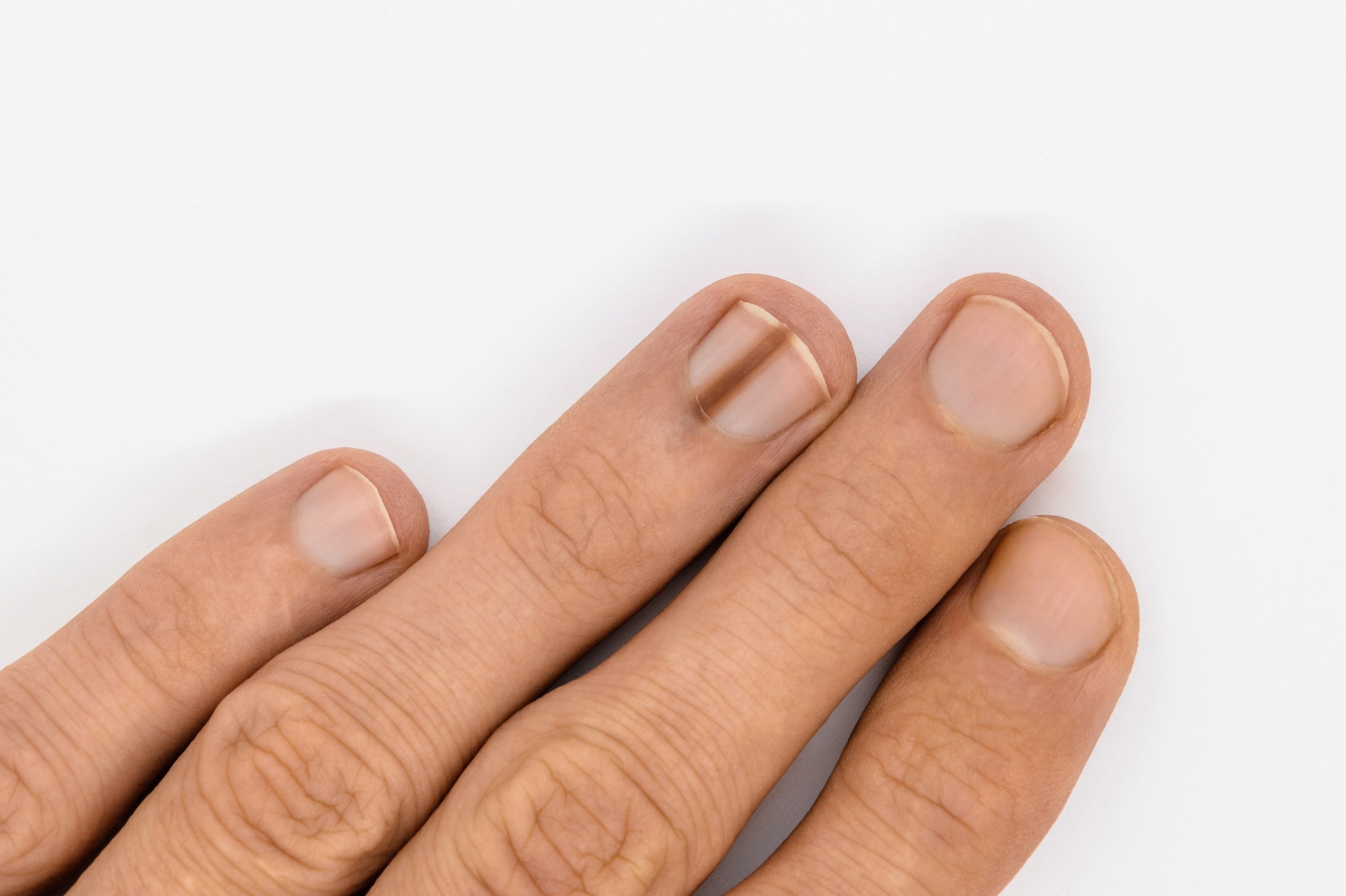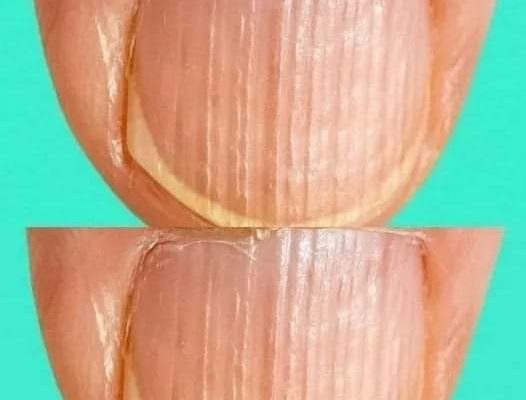Introduction
Longitudinal ridging, which is clinically known as onychorrhexis, occurs on the nails and may appear as vertical striations or lines that originate from the base of the fingernail and continue to the end of the nail. The severity of these ridges can range from a few superficial ridges to deep furrows, with the ridges affecting a small portion of the nail surface to up to 70% of the nail in severe cases.
 Longitudinal ridging. Image Credit: NAOWARAT / Shutterstock
Longitudinal ridging. Image Credit: NAOWARAT / Shutterstock
Development of a normal nail
The nail plate, more commonly referred to as the nail, consists primarily of hard keratin. Typically, the nail plate is about 0.5 millimeters (mm) thick and slightly curved.
The nail is firmly attached to the nail bed, which is located directly beneath the nail. Within the nail bed are numerous capillaries that provide oxygen to the opaque exposed part of the nail.
The nail matrix, which is the location where the nail is tucked into the skin, constantly produces new keratin that gathers at the nail plate. The production of this new keratin pushes out older cells, thus causing the nail to grow forward.
Nails grow about three mm each month; thus, the nail renews itself every four to six months. Notably, fingernails grow faster than toenails, with nails often growing faster in the summer as compared to the winter. As a person ages, the rate of nail growth declines.
 Nail anatomy structure diagram. Image Credit: VectorMine / Shutterstock
Nail anatomy structure diagram. Image Credit: VectorMine / Shutterstock
How does the appearance of nails reflect health?
In healthy individuals, nails are evenly formed and pink in color. However, discoloration, dullness, thickening of the nail, or other abnormal appearances may indicate more serious health problems.
The nails are immediately affected when the body is fighting an infection or facing a nutritional deficiency, as the capillaries feeding the nail bed tend to pass infected blood to the nails. Thus, clinicians are often advised to thoroughly inspect their patients’ fingernails and toenails during routine examinations, particularly when an illness is suspected.
Is longitudinal ridging indicative of a health issue?
The most common reason for the formation of vertical or longitudinal ridges in the absence of actual disease is a lack of moisture and improper nutrition. As the nails age, their capacity to absorb nutrients diminishes, subsequently affecting their growth.
In healthy individuals, it is normal to find some lines from the cuticle to the top of the nail. In fact, many middle-aged women will often experience some degree of longitudinal ridging, considered a normal aging process of nails.
Nails also lose their luster during aging and may appear opalescent and dull. These nail changes are not indicative of serious disease and instead reflect the failing regeneration properties of an aging human body.
Conversely, the nails of individuals with onychorrhexis often have deeper ridges that can feel rough to the touch. This is because the folds in these nails are deeper and cause the nail surface to become uneven. These ridges are often accompanied by brittle nails prone to splitting and leaving behind jagged edges.
Longitudinal ridging can be caused by various medical conditions, including systemic amyloidosis, nail-patella syndrome, collagen vascular diseases, graft versus host disease, and rheumatoid arthritis.
Prognosis and accurate diagnosis can help in the treatment of longitudinal ridging. Depending on the precision of the treatment, the ridges may completely resolve in some cases.
Although affected nails will not change, new nails may be void of ridging if the underlying medical problem is resolved; however, this may not occur for six months up to several years. In addition, in some diseases, nail ridging may be a symptom that is difficult to eliminate.
Different types of nail lines
In addition to onychorrhexis, several other types of lines can develop on nails and indicate different health issues. These can include leukonychia striata, longitudinal melanonychia, longitudinal erythronychia, and nail plate grooves.
Leukonychia striata
Leukonychia striata, which refers to white lines on the nails, can be categorized as true or apparent leukonychia, depending on their origin.
True leukonychia
True leukonychia causes aberrant keratinization in the nail matrix, which subsequently leads to parakeratosis, a condition that is defined as the incomplete maturation of epidermal keratinocytes in the nail plate. This form of leukonychia can cause the nail to appear opaque, particularly at distal locations of the nail after it has grown out, and is often accompanied by transverse or longitudinal lines. However, when pressure is applied to these nails, the white discoloration remains unchanged.
 White spots on fingernails (Leukonychia). Image Credit: Nadya So / Shutterstock
White spots on fingernails (Leukonychia). Image Credit: Nadya So / Shutterstock
Nearly 50% of true leukonychia cases arise due to fungal infections, which present as dense, uneven, and white or yellow longitudinal lines on the nail plate.
In addition to fungal causes of true leukonychia, this form of nail discoloration can also indicate a rare autosomal dominant condition such as Hailey-Hailey disease or Darier disease. Patients with Hailey-Hailey disease, for example, will often have multiple parallel longitudinal white lines that originate from the nail lunula, which is the visible moon-shaped white matrix where the nail leaves the cuticle.
True leukonychia may also take the form of Mees lines, one- to two mm wide transverse white lines that appear across the width of the nail plate. Typically, Mees lines will affect all fingernails and may indicate arsenic or other heavy metal poisonings, acute renal failure, heart failure, ulcerative colitis, and breast cancer. In addition, certain infections such as measles, systemic lupus erythematosus, and tuberculosis may also cause Mees lines to develop.
Apparent leukonychia
Conversely, apparent leukonychia arises due to abnormal vasculature of the nail bed. This causes the nail to become translucent, with the whiteness of the nail disappearing after pressure is applied.
Apparent leukonychia causes the nail plate to become translucent by changing the nail bed vasculature. Unlike true leukonychia, the whiteness in apparent leukoncyhia is unaffected by nail growth and originates in the nail bed. There are three different types of apparent leukonychia: Muehrcke lines, half-and-half nails, and Terry nails.
Muehrcke lines are white transverse bands that run parallel to the lunula and often span the nail bed. This form of apparent leukonychia may indicate human immunodeficiency virus (HIV) infection, acquired immunodeficiency syndrome (AIDS), liver disease, or malnutrition. Additionally, patients who have received an organ transplant or are currently undergoing chemotherapy treatment may also exhibit Muehrcke lines.
Half-and-half nails, which are also referred to as ‘Lindsay nails,’ describe nails that have a pink or red-brown line that is adjacent to a sharp demarcation, followed by a white band near the center of the nail. Some of the different health conditions that half-and-half nails may indicate include Kawasaki disease, Crohn’s disease, zinc deficiency, liver cirrhosis, Behcet disease, and pellagra.
Terry nails occur when the leukonychia covers more than 80% of the total nail bed. This condition may indicate the presence of liver cirrhosis that is secondary to alcoholism. Additionally, heart failure, type 2 diabetes, reactive arthritis, old age, Hansen disease, peripheral vascular disease, and pulmonary tuberculosis may cause Terry nails to develop.
Longitudinal melanonychia
Longitudinal melanonychia, which describes black-brown vertical lines in the nail plate, could indicate a wide range of illnesses, including trauma, infections from bacteria, fungi, or human immunodeficiency virus (HIV), endocrine disorders, exogenous pigmentation, or simply excess production of melanin within the matrix.
This form of nail discoloration may also indicate benign or malignant conditions. Benign melanocytic activation, lentigines, or nevi are some of the benign conditions that may cause this skin discoloration.
Conversely, longitudinal melanonychia may be an early sign of melanoma; however, its association with this condition is not common.
 Male hand with a brown line on one of the finger’s nail better known as melanonychia (nail pigmentation). Image Credit: Rytis Bernotas / Shutterstock
Male hand with a brown line on one of the finger’s nail better known as melanonychia (nail pigmentation). Image Credit: Rytis Bernotas / Shutterstock
Longitudinal erythronychia
Longitudinal erythronychia describes the presence of one or more vertical red lines in the nail. When this condition only affects one nail, it is typically due to a cancerous process. This type of localized nail discoloration is also often indicative of a benign glomus tumor.
Comparatively, polydactylous longitudinal erythronychia indicates an underlying systemic disease such as lichen planus or Darier disease. About 10% of patients with the skin disease lichen planus will experience nail symptoms, with 4% of patients suffering from permanent nail dystrophy.
Nail plate grooves
Nail plate grooves also referred to as beau lines, are commonly identified in clinical settings. These transverse grooves arise due to reduced nail growth within the nail matrix, which may occur following periods of acute or chronic stress. Some systemic diseases that may cause nail plate grooves to develop include rheumatic fever, malaria, pemphigus, Raynaud disease, and myocardial infarction.



